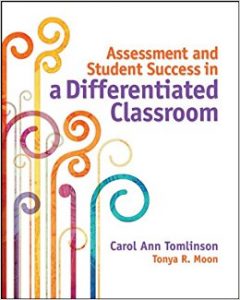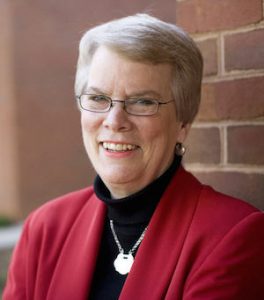Carol Ann Tomlinson is one of America’s outstanding thought leaders in the area of developing K12 classrooms that provide effective instruction for academically diverse student populations. She’s an honored professor at the University of Virginia and an expert in differentiated instruction (her books on the subject are available in 13 languages). Most important, perhaps, Tomlinson’s research and writing are framed by her experience as a classroom teacher for 21 years, working with high school, preschool, and middle school students, as well as administering district programs for struggling and advanced learners.
 Tomlinson’s new book from ASCD, Assessment and Student Success in a Differentiated Classroom, is co-authored with her UVA colleague Tonya Moon.
Tomlinson’s new book from ASCD, Assessment and Student Success in a Differentiated Classroom, is co-authored with her UVA colleague Tonya Moon.
In the Preface, Tomlinson writes that “this book is a practical one designed for teachers who work in real classrooms, with real students, amid the real pressures of schools every day.” It’s a wonderful book that we’ve been recommending to educators in all of our ABPC-supported professional networks this fall.
Recently, ABPC’s Cathy Gassenheimer asked Dr. Tomlinson if she would participate in an interview about the book and her work. She generously agreed and were pleased to offer the interview here in two parts. This is the first segment – the second will be posted on November 25.
Cathy Gassenheimer: With the new standards, a teacher’s ability to effectively differentiate is even more important than ever. In the overview to your new book, you remind us that, “in a differentiated classroom, the teacher’s aim is to make the classroom work for each student…” (p. 4) What role does assessment play in helping a teacher actualize that differentiated classroom?
Carol Ann Tomlinson: Formative assessment is really a compass for daily planning. Lorna Earl, a Canadian educator and author, says in one of her books that if teachers have clear learning targets in mind and assess to understand where students are relative to those goals at a given time, differentiation will no longer look like an “extra,” but rather will be the next logical step. I think she’s right.
Formative assessment is equivalent to tests a doctor runs to know what to do next. The tests aren’t ever 100% reliable, but they lead to way better results than just diagnosing by hunch. So, formative assessment helps us plan for instruction more intelligently, which helps students learn better from their varied entry points – and it’s a reminder of the need for differentiation.
It’s also important to note that formative assessment is very important in helping students understand their own status relative to important goals and to helping them learn to plan wisely for their own growth – to own their learning.
Cathy: In chapter 3, you caution against teaching to the standardized test. Linda Darling-Hammond, John Hattie and others have found compelling information that should be able to help teachers move away from teaching to the test toward teaching the new high standards to mastery. Yet, most teachers I talk with are afraid if they don’t teach to the test, their results will look bad. In what ways can we help them trust the research in this area?
 Carol Ann: Teachers are afraid not to teach to the test because a broad range of leaders have made them afraid. Some studies indicate that in some buildings, principals consistently give the message (and live it out) that educators should be about learning to teach better and better, and that when they do, test scores follow. In other buildings, the message is that the mission is to raise the test score and failure to do so is not acceptable – and that’s what’s lived out.
Carol Ann: Teachers are afraid not to teach to the test because a broad range of leaders have made them afraid. Some studies indicate that in some buildings, principals consistently give the message (and live it out) that educators should be about learning to teach better and better, and that when they do, test scores follow. In other buildings, the message is that the mission is to raise the test score and failure to do so is not acceptable – and that’s what’s lived out.
Students achieve better in the buildings where leaders encourage and support better teaching. I suspect that in those places, teachers and students don’t feel as shell-shocked, either. I think we need shared conversations about what it means to be a professional, and I don’t think our profession is test-prep.
Cathy: You tell a compelling story at the beginning of chapter 6, from your own early teaching experience, about a 15-year old student’s revelation to you that he couldn’t read. In Alabama – like every other state – we have many students entering different grades far behind. Can you share your insights with teachers and instructional coaches who are working to help every one of their students be academically successful?
Carol Ann: I understood almost instantly that the boy you are referencing had taken a huge risk in confessing his problem to a stranger in the school corridor. It was a cry for help and I knew I couldn’t walk away from him. I worked really hard with the student and he invested all he had in his growth as well. His reading level improved markedly.
But I learned way more from the experience than he did. I learned that what we’ve now come to call “differentiation” works much more “naturally” when I understand that many/most students will need me in different ways at least some of the time, rather than when I see differentiation as something only for one or two outliers.
Beginning with that experience, I learned to organize my curriculum with greater clarity, which helped me know what to differentiate and for whom. I learned the importance of my interactions with students and the importance of my “public” messages about student capacity in making differentiation sensible in students’ eyes. I learned about the imperatives of flexible grouping and respectful tasks.
While I didn’t name most of those things in the early years of my learning, this courageous little fella was the catalyst for the rest of my career in terms of seeing the humanity of every student and responding accordingly. It’s also important to say that I generally had no idea whether what I was doing with him was “right.” I just knew I had to try.
At that point, I had no training in teaching reading, curriculum design, assessment, etc. I just tried something, studied what happened, and either maintained a direction or changed it depending on what I saw. We need to trust our common sense and instincts.
Cathy: Throughout your book, you stress the importance of focusing on a student’s KUD, your term for a learning target – what we want students to know, understand, and be able to do. In fact, in chapter 4, you say that: “In differentiating assessments, one attribute should almost always remain unchanged across all versions of the assessment: the knowledge, understanding, and skill for which students are responsible.” (p. 45). Why?
Carol Ann: KUDs (learning targets) contain the core of what we’re obligated to teach. In a standards-based era, we are accountable for the KUDs stated or implied in the standards. It’s also critical, though, that we understand that standards alone are not a curriculum. They’re ingredients for a curriculum.
We have to add, arrange, combine, etc. to create a KUD framework for meaning – something that clarifies important content for students and that is successful in engaging their mental energies. That requires “standards plus.” With the exception of some students with IEPs, we’re obligated to hold the same learning goals as the core of learning for all our students. However, that doesn’t eliminate the reality that we’ll need to “teach backwards” for some of our students who have gaps in their learning, even as we “teach forwards” to the KUDs.
Nor does it eliminate the reality that some of our students already have mastery of the required KUDs, or will achieve it quickly, and we need to extend the KUDs (especially the understandings) for those students. Learning to teach backwards and ahead while we maintain a forward momentum toward the required KUDs is a big part of successful differentiation. In other words, we have to develop comfort in dealing with the reality of required goals as well as with very real student differences.
In the second part of our interview, Carol Ann Tomlinson talks about respect and high expectations for both students and teachers. And she shares a memorable list of enduring truths about being a teacher. Click here for second part.

0 Comments on "Success, Student-by-Student: Our Interview with Carol Ann Tomlinson"